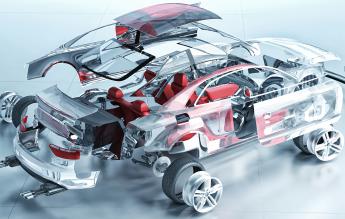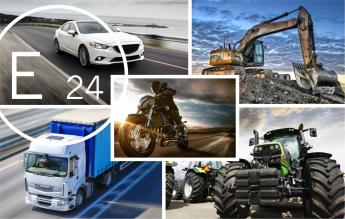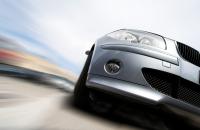
In the context of Euro 6 approvals and future developments, a series of requirements must be satisfied, including measurements of pollutant emissions (gaseous pollutants and particles) based on laboratory measurements of exhaust emissions (using the WLTC cycle) supplemented by measurements of emissions under real driving conditions (RDE) carried out by a (PEMS).
Measurements in real-life driving conditions allow the correlation of pollutant emissions between the measurements made in the laboratory for the homologation cycle and the vehicle driven on the road every day.
The RDE tests are performed on open roads. These tests follow the different stages of the WLTC cycle. They must therefore begin with an urban section, followed by an out-of-town section and a freeway section. The tests in real driving conditions are carried out on roads with an altitude of less than 700 meters and temperatures between 0°C and 30°C.
All greenhouse gas and pollutant emissions are measured during an RDE test, but only NOx emissions are discriminating. Thus, for Euro 6d full, NOx emissions must not exceed 1.5 times the permissible emissions for a vehicle approved under this standard.
Note that in the context of Euro 6 homologation (and its future variations), RDE measurements are also required for ISC measurements.
This test is for vehicles already on the road that must also have remained compliant with emissions regulations. These tests are mandatory for all registrations as of January 1, 2019 and for all new registrations as of September 1, 2019.
The manufacturer must guarantee the conformity of the vehicle with the homologation data for a minimum of 5 years or 100,000 km, whichever comes first. In-service conformity refers to laboratory and real driving gas emission tests and evaporation tests.
The Joint Research Centre (JRC) the European Union's scientific and technical research laboratory, has published a Guidance note for light-duty vehicles on roadside testing using PEMS.
This guidance note provides best practice for the preparation, execution and monitoring of emissions tests that are carried out with PEMS on board light-duty vehicles (LDV) equipped with conventional combustion engines (petrol, diesel, CNG, LPG), in particular to test vehicles in accordance with the European RDE legislative requirements set out in Regulations (EU) 2017/1151, 2016/427, 2016/646, 2017/1154 and the latest RDE act4 package (Regulation 2018/1832 and corrigeum), collectively referred to in this document as the EU-RDE LDV Regulations.
RDE measurements using PEMS fall into 3 main categories:
More specifically for the EU-RDE-TA and EU-RDE-ISC tests, the following vehicle selection criteria apply (non-exhaustive list):
There are many factors to consider, both mandatory and recommended
Regarding the test conditions, the following table presents the requirements (for requirements and recommendations for tests other than those defined in the EU-RDE-TA and EU-RDE-ISC, these can be found in the Guidance note for light-duty vehicles :
| Condition | EU-RDE-TA & EU-RDE-ISC requirements |
| Test duration | 90 to 120 minutes |
| Engine start | In order to assess the emissions during trips in hot start, a certain number of vehicles per PEMS test family shall be tested without conditioning but with a warm engine. An engine can be considered as warm when the engine coolant temperature and/or engine oil temperature is above 70 ºC. |
| Test route requirements - Urban, rural and motorway definitions and shares |
- Urban, rural and motorway driving defined by speed: - Urban, rural and motorway driving minimum distance: 16 km The vehicle velocity shall normally not exceed 145 km/h. This maximum speed may be exceeded by a tolerance of 15 km/h for not more than 3 % of the time duration of the motorway driving. Local speed limits remain in force at a PEMS test, notwithstanding other legal consequences. |
| Test route requirements - Average speed and stop times | - Urban average speed: ≥15 km/h and ≤ 40 km/h - Cold start average speed including stops: ≥15 km/h and ≤ 40 km/h - Cold start maximum speed ≤ 60 km/h - Stop periods (when vehicle speed < 1km/h) shall account for 6 –30% of time duration of urban phase. No stop shall exceed 300 seconds or the trip will be voided. - Stop period during cold start ≤ 90 seconds |
| Ambient conditions – Temperature | - Moderate: ≥ 0°C and ≤ 30°C - Extended: (≥ -7°C and < 0°C) or (> 30°C and ≤ 35°C) Derogation limits(for new vehicles or types of véhicules depending of the different categories see more): - Moderate: 3°C to 30°C - Extended: -2°C to <3°C and >30°C to 35°C |
| Ambient conditions – Altitude | - Moderate: ≤ 700 m above sea level - Extended: >700 m and ≤ 1300m above sea level - Maximum altitude difference between start and end point: 100 m - Maximum cumulative altitude gain: 1200 m per 100km. Valid for both the urban and total trip. |
| Road conditions | EU-RDE-TA and EU-RDE-ISC cannot be performed on unpaved roads. In addition, even though the EU-RDE LDV regulations do not specify this point, common sense and safety recommend avoiding extreme weather conditions (mud, icy roads, and fresh snow). |
| Fuel lubricating oil, reagent | Vehicles must be run using market fuel, oil, and reagent, always following the recommendations of the vehicle's manufacturer. It is require d to collect a sample of the test fuel(s), oil and reagent(s) for EU-RDE tests whenever the emissions are above the NTE limit. |
| Driving Time | Tests should be conducted during normal working days (Monday to Friday). Recommended hours range from 7am to 8pm. |
| Vehicle payload | The vehicle's basic payload shall comprise the driver, a witness of the test (if applicable) and the test equipment, including the mounting and the power supply devices. The total shall not exceed 90% of the vehicle's permissible payload. |
| Vehicle pre-conditioning | Before an EU-RDE-TA or EU-RDE-ISC test, the vehicle has to be driven for at least 30 minutes, parked with doors and bonnet closed and kept in engine-off status between 6 and 56 hours within moderate or extended altitude and temperatures conditions. Soaking temperature 3 hours prior to the test must be recorded. It is recommended to drive in normal roads and at least 20 to 25 minutes on the motorway to limit the risk of regeneration of the DPF during the actual test. In general terms, the recommendations regarding the use of vehicle air-conditioning, auxiliary devices, payload, road condition, gear shifting, tyre conditions and the driver behaviour apply to the pre-conditioning drive. When several EU-RDE tests are conducted in consecutive days, the previous day EU-RDE test can be used as pre-conditioning drive for the current day test. Problems identified during the pre-conditioning and the total soaking time should be reported. It is not necessary to make use of the PEMS instruments during the pre-conditioning drive. However, its use is encouraged to identify potential problems with the instrumentation performance or in the recording that may prevent/delay the actual EU-RDE test. During the parking in low temperatures it might be wise to heat the PEMS equipment using an external source in order to avoid issues of condensation. For a hot EU-RDE test, the vehicle shall be driven to reach an engine oil or engine coolant temperature above 70C. Then the engine shall be stopped, and the pre-test shall be performed (calibration of PEMS system). |
| Vehicle air-conditioning and auxiliary devices |
The air conditioning system or other auxiliary devices can be operated in a way which corresponds to their possible use by a consumer at real driving on the road. Any misuse of the air-conditioning system should be avoided, such as for instance using it with open windows, if not needed for the measuring equipment. The recommended temperature for the comfort of the passenger(s) is in the range of 20 to 24°C. All original auxiliary devices available to the user are allowed (i.e. only original devices from the Manufacturer). Any use shall be documented. Electrical auxiliaries that are automatically shut-down when their goal is achieved (i.e. rear window heating, mirror heating, etc.) should only be re-started again if actually needed for a safe driving. |
| Vehicle gear shift and operating modes | When several gear shift and/or vehicle operating modes are available the vehicle can be tested under any mode: eco, standard, sport, etc. with the exception of the off-road modes (for non-paved roads). It is however recommended to use the predominant mode, including the D (drive) mode for automatic transmissions. OVC-HEVs vehicles may be tested in any selectable mode (charge depleting, charge sustaining), including battery charge mode. In case a vehicle has a "race" mode, to be used only on test tracks, this mode shall not be used for EU-RDE testing, as safety features might be disabled. It is strongly recommended not to disable safety related vehicle modes (e.g. ABS, DSC, ADM, ESP, etc.) in case the test is carried by non-professional drivers. |
| Vehicle battery | Vehicles should not be tested with an empty battery. In case the vehicle has problems starting, the battery may be replaced following the recommendations of the vehicle's manufacturer. The vehicle shall then be pre-conditioned as indicated above and tested. It is possible to charge the battery prior to the pre-conditioning but not before the start of an EU-RDE-TA or EU-RDE-ISC tests. |
| Vehicle tyres |
The tyre types and pressure shall be according to the vehicle's manufacturer recommendations. The tyre pressure shall be checked prior to the pre-conditioning and adjusted to the recommended values if needed. The tyre profile depth should be verified according to the recommendations of customer safety associations (e.g. ADAC), but should have at least 3mm of tread depth for summer tyres and 4 mm for winter tyres. The use of chains is not permitted since the EU-RDE trip speed requirements cannot be fulfilled and it is not recommended to drive on snow during EU-RDE tests and it is not recommended to drive under extreme weather conditions during EU-RDE tests. |
Any mapping device can be used to define a route that can comply with the requirements of the EU-RDE test, including the required urban/rural/highway distance shares, the altitude difference between the start and end point and the cumulative altitude gain.
For EU-RDE-TA and EU-RDE-ISC tests:
Once the route(s) have been defined, it is recommended that they be "tested", using a data logger to record vehicle speed and altitude. It is recommended to perform these tests at the times of day scheduled for the full EU-RDE test with the PEMS. Depending on the local traffic situation and potential traffic jams, it is also advisable to design alternative routes and/or local detours. It is also recommended to avoid using the same street more than twice in a specific route.
It is suggested not to always choose the same route for each EU-RDE test, but to vary them. It is also recommended that the hot EU-RDE test is performed on the same route as the equivalent cold tests.
Tyre pressure - Tyre tread depth - OBD check - Are there any warning lights activated on the dashboard? - Vehicle fluids - Aerodynamic modifications - Mileage (EU-RDE-TA: 3,000 - 15,000, EU-RDE-ISC: 15,000 - 100,000 km) - Age of the vehicle - Country of registration and use - Is the vehicle subject to a recall or maintenance campaign - Has the vehicle been used for racing/motor sport - Has the vehicle carried heavy loads beyond the manufacturer's specifications? - Check for signs of tuning - Has any part of the emission after-treatment system been replaced - Service and repair history
Instrument Installation (detailed by PEMS component)
Pre-test procedures
Perform the test
Post-test
Conclude the test run (dismantle the PEMS)













Emitech Group - Legal information